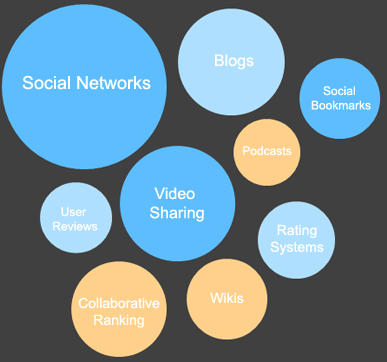Are Social Media, Social? (Part Nine)
 Tuesday, May 25, 2010 at 1:13PM
Tuesday, May 25, 2010 at 1:13PM The ties that bind connect people, families and communities but those ties remain limited and small in number however richly endowed they may appear to be within the context of discussions about social media. As I mentioned in my previous post, this is a fragile ecology that assumes among other things, that people will stay on top of their connections to each other and maintain the strength and frequency of their conversations over time.

It also means that the participatory qualities of social media can be sustained amidst the ever expanding information noise coming at individuals from many different sources. Remember, sharing information or even contributing to the production of information doesn’t mean that users will become more or less social. The assumption that social media users make is that they are being social because they are participating within various networks, but there is no way of knowing other than through some really hard edged research whether that is really the case.
One of the most fascinating aspects of social media is what I would describe as statistical overload or inflation. “There are now more Facebook users in the Arab world than newspaper readers, a survey suggests. The research by Spot On Public Relations, a Dubai-based agency, says there are more than 15 million subscribers to the social network. The total number of newspaper copies in Arabic, English and French is just under 14 million.” (viewed on May 25, 2010). I am not sure how these figures were arrived at since no methodology was listed on their website. The company is essentially marketing itself by making these statistics available. There are hundreds of sites which make similar claims. Some of the more empirical studies that actually explain their methodologies still only sample a small number of users. Large scale studies will take years to complete.
The best way to think of this is to actually count the number of blogs that you visit on a regular basis or to look at the count of your tweets. Inevitably, there will be a narrowing not only of your range of interests but of the actual number of visits or tweets that you make in any given day. The point is that statistics of use tell us very little about reading, depth of concern or even effects.
The counter to this argument goes something like this. What about all those YouTube videos that have gone viral and have been seen by millions of viewers? Or, all the Blogs that so many people have developed? Or, the seemingly endless flow of tweets?
Jakob Nielsen at useit.com who has been writing about usability for many years makes the following claim. “In most online communities, 90% of users are lurkers who never contribute, 9% of users contribute a little, and 1% of users account for almost all the action. All large-scale, multi-user communities and online social networks that rely on users to contribute content or build services share one property: most users don't participate very much. Often, they simply lurk in the background. In contrast, a tiny minority of users usually accounts for a disproportionately large amount of the content and other system activity.” (viewed on May 25, 2010) Neilsen’s insights have to be taken seriously.
The question is why are we engaging in this inflated talk about the effects and impact of social media? Part of the answer is the sheer excitement that comes from the mental images of all these people creating, participating, and speaking to each other even if the number is smaller than we think. I see these mental images as projections, ways of looking at the world that more often than not link with our preconceptions rather than against them.
So, here is another worrying trend. When Facebook announces 500 million people using its site(s), this suggests a significant explosion of desire to create and participate in some form of communications exchange. It says nothing about the content (except that Facebook has the algorithms to mine what we write) other than through the categories Facebook has, which do tend to define the nature of what we exchange. For example, many users list hundreds of friends which becomes a telling sign of popularity and relevance. It is pretty clear that very few members of that group actually constitute the community of that individual. Yet, there is an effect in having that many friends and that effect is defined by status, activities and pictures as well as likes and dislikes.
None of this is necessarily negative. The problem with the figure 500 million is that it projects a gigantic network from which we as individuals can only draw small pieces of content. And, most of this network is of necessity virtual and detached from real encounters. This detachment is both what encourages communication and can also discourage social connections. This is why privacy is so important. It is also why the anti-Facebook movement is gathering strength. The honest desire to communicate has been supplanted by the systematic use of personal information for profit.
Part Ten Follow on me Twitter @ronburnett


![Reblog this post [with Zemanta]](http://img.zemanta.com/reblog_e.png?x-id=ad3106e8-64d0-445b-8d8d-f54233a8edb0)
